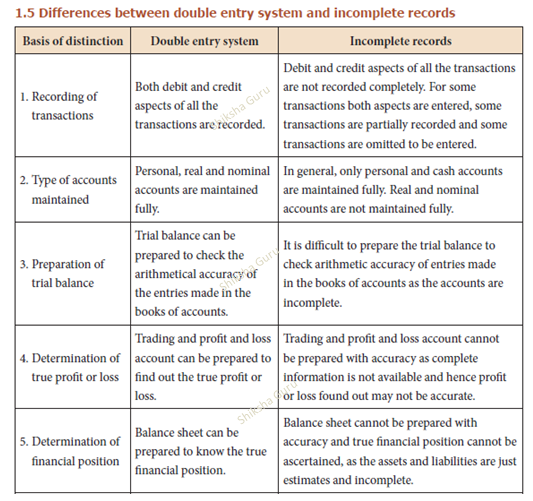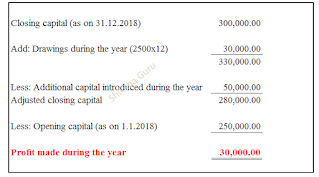Accounts from Incomplete Records - TN State Board 12th Accountancy Book Back Solution Guide
Chapter 1 Accounts from incomplete records
I. Choose the correct answer
1. Incomplete records are generally
maintained by
(a)
A company (b) Government
(c)
Small sized sole trader business (d) Multinational enterprises
Answer: (c) Small Sized sole trader business
2. Statement of affairs is a
(a)
Statement of income and expenditure (b) Statement of assets and liabilities
(c)
Summary of cash transactions (d) Summary of credit transactions
Answer: (b) Statement of assets and liabilities
(a) Capital in the beginning of
the year (b) Capital at the end of the year
(c)
Profit made during the year (d) Loss occurred during the year
Answer: (a) Capital in the beginning of the year
4. The excess of assets over liabilities is
(a)
Loss (b) Cash (c) Capital (d) Profit
Answer: (c) Capital
5. Which of the following items relating to bills payable is transferred to total creditors account?
(a)
Opening balance of bills payable (b) Closing balance of bills payable
(c) Bills
payable accepted during the year (d) Cash paid for bills payable
Answer: (c) Bills payable accepted during the year
6. The amount of credit sales can be
computed from
(a)
Total debtors account (b) Total creditors account
(c)
Bills receivable account (d) Bills payable account
Answer: (a) Total debtors account
7. Which one of the following statements is not true in relation to incomplete records?
(b) Records are maintained only for
cash and personal accounts
(c) It is suitable for all types
of organisations
(d) Tax authorities do not accept
Answer: (c) It is suitable for all types of
organisations
8. What is the amount of capital of
the proprietor, if his assets are ₹85,000 and liabilities are ₹21,000?
(a)
₹ 85,000
(b) ₹ 1,06,000
(c) ₹ 21,000
(d) ₹ 64,000
Answer: (d) ₹64,000
9. When capital in the beginning is ₹10,000, drawings during the year are ₹6,000, profit made during the year is ₹2,000 and the additional capital introduced is ₹3,000, find out the amount of capital at the end.
(a)
₹ 9,000
(b) ₹ 11,000
(c) ₹ 21,000
(d) ₹ 3,000
Answer: (a) ₹9,000
10. Opening balance of debtors: ₹ 30,000,
cash received: ₹
1,00,000, credit sales: ₹ 90,000; closing balance of debtors is
(a)
₹ 30,000
b) ₹ 1,30,000
c) ₹ 40,000
d) ₹ 20,000
Answer: (d) ₹20,000
II Very short answer questions
12th Standard Chapter 1 Question No.1
What is meant by incomplete records?
Answer:
When
accounting records are not strictly maintained according to double entry
system, these records are called incomplete accounting records.
Generally, cash account and the personal accounts of customers and creditors are maintained fully and other accounts are maintained based on necessity.
12th Standard Chapter 1 Question No.2
State
the accounts generally maintained by small sized sole trader when double entry
accounting system is not followed.
Answer:
Only cash account and personal
accounts are maintained by small sized sole trader when double entry accounting
system is not followed.
12th Standard Chapter 1 Question No.3
What is a statement of affairs?
Answer:
A statement of affairs is a statement showing the balances of assets and liabilities on a particular date. The balances of assets are shown on the right side and the balances of liabilities on the left side. This statement resembles a balance sheet. The difference between the total of assets and total of liabilities is taken as capital.
Capital = Assets – Liabilities
III
Short answer questions
12th Standard Chapter 1 Short Answer Question No.1
What are the features of incomplete records?
Answer:
Following are the features of
incomplete records:
(i) Nature: It is an
unscientific and unsystematic way of recording transactions. Accounting
principles and accounting standards are not followed properly.
(ii) Type of accounts
maintained: In general, only cash and personal accounts are maintained
fully. Real accounts and nominal accounts are not maintained properly. Some
transactions are completely omitted.
(iii)
Lack of uniformity: There is no uniformity in recording the transactions
among different organisations. Different organisations record their
transactions according to their needs and conveniences.
(iv)
Financial
statements may not represent true and fair view: Due to the incomplete
information and inaccurate records of accounts, the profit or loss calculated
from these records cannot be relied upon. It may not represent true
profitability. Assets and liabilities may not represent a true and fair view of
financial position.
(v) Suitability: Only the
business concerns which have no legal obligation to maintain books of accounts
under double entry system may maintain incomplete records. Hence, it may be
maintained by small sized sole traders and partnership firms.
(vi) Mixing up of personal and business transactions: Generally, personal transactions of the owners are mixed up with the business transactions. For example, purchase of goods for own use may be mixed up along with business purchases.
12th Standard Chapter 1 Short Answer Question No.2
What are the limitations of incomplete records?
Answer:
Following are the limitations of incomplete records:
(i) Lack of proper maintenance
of records: It is an unscientific and unsystematic way of maintaining
records. Real and nominal accounts are not maintained properly.
(ii) Difficulty in preparing
trial balance: As accounts are not maintained for all items, the accounting
records are incomplete. Hence, it is difficult to prepare trial balance to
check the arithmetical accuracy of the accounts.
(iii) Difficulty in
ascertaining true profitability of the business: Profit is found out based
on available information and estimates. Hence, it is difficult to ascertain
true profit as the trading and profit and loss account cannot be prepared with
accuracy.
(iv) Difficulty in
ascertaining financial position: In general, only the estimated values of
assets and liabilities are available from incomplete records. Hence, it is
difficult to ascertain true and fair view of state of affairs or financial
position as on a particular date.
(v) Errors and frauds cannot
be detected easily: As only partial records are available, it may not be
possible to have internal checks in maintaining accounts to detect errors and
frauds.
State the differences between double entry system and incomplete records.
Answer:
12th Standard Chapter 1 Short Answer Question No.4
State the procedure for calculating profit or loss through statement of affairs.
Answer:
The
difference between the closing capital and the opening capital is taken as
profit or loss of the business. Due adjustments are to be made for any
withdrawal of capital from the business and for the additional capital
introduced in the business.
Adjusted closing capital = Closing capital + Drawings – Additional capital
Closing Capital + Drawings – Additional Capital – Opening Capital = Profit/ Loss
12th Standard Chapter 1 Short Answer Question No.5
Differentiate between statement of affairs and balance sheet.
Answer:
Answer:
12th Standard Chapter 1 Exercise No.9








































































Comments
Post a Comment